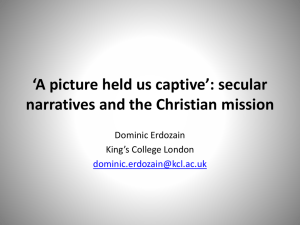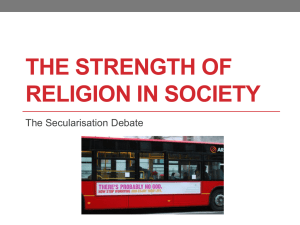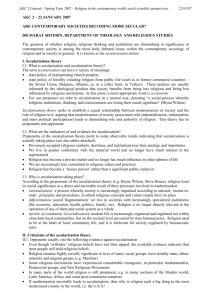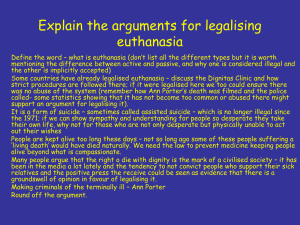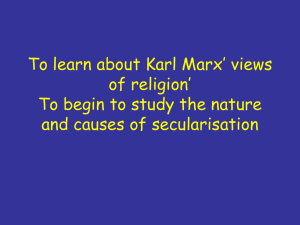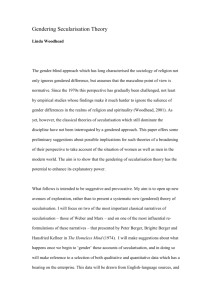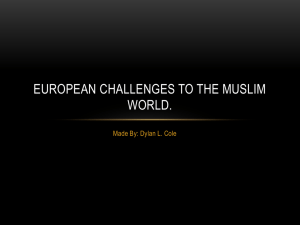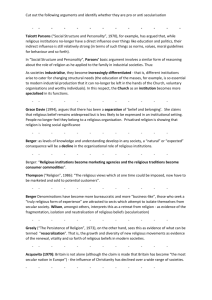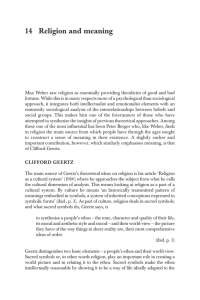report - Centre for History and Economics
advertisement
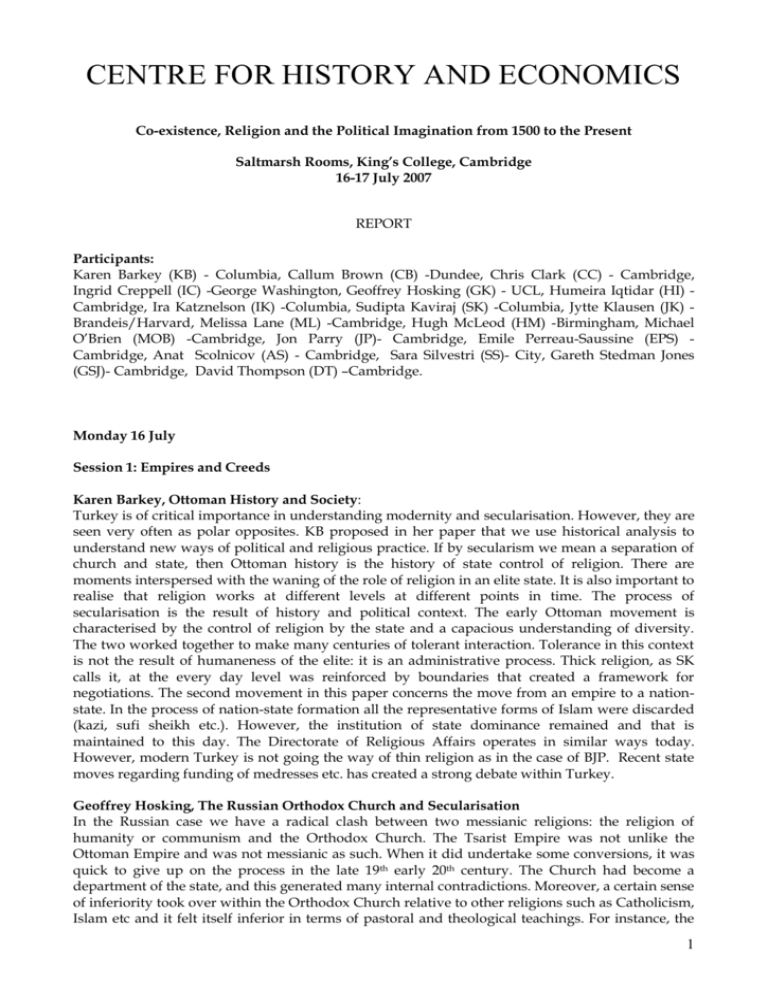
CENTRE FOR HISTORY AND ECONOMICS Co-existence, Religion and the Political Imagination from 1500 to the Present Saltmarsh Rooms, King’s College, Cambridge 16-17 July 2007 REPORT Participants: Karen Barkey (KB) - Columbia, Callum Brown (CB) -Dundee, Chris Clark (CC) - Cambridge, Ingrid Creppell (IC) -George Washington, Geoffrey Hosking (GK) - UCL, Humeira Iqtidar (HI) Cambridge, Ira Katznelson (IK) -Columbia, Sudipta Kaviraj (SK) -Columbia, Jytte Klausen (JK) Brandeis/Harvard, Melissa Lane (ML) -Cambridge, Hugh McLeod (HM) -Birmingham, Michael O’Brien (MOB) -Cambridge, Jon Parry (JP)- Cambridge, Emile Perreau-Saussine (EPS) Cambridge, Anat Scolnicov (AS) - Cambridge, Sara Silvestri (SS)- City, Gareth Stedman Jones (GSJ)- Cambridge, David Thompson (DT) –Cambridge. Monday 16 July Session 1: Empires and Creeds Karen Barkey, Ottoman History and Society: Turkey is of critical importance in understanding modernity and secularisation. However, they are seen very often as polar opposites. KB proposed in her paper that we use historical analysis to understand new ways of political and religious practice. If by secularism we mean a separation of church and state, then Ottoman history is the history of state control of religion. There are moments interspersed with the waning of the role of religion in an elite state. It is also important to realise that religion works at different levels at different points in time. The process of secularisation is the result of history and political context. The early Ottoman movement is characterised by the control of religion by the state and a capacious understanding of diversity. The two worked together to make many centuries of tolerant interaction. Tolerance in this context is not the result of humaneness of the elite: it is an administrative process. Thick religion, as SK calls it, at the every day level was reinforced by boundaries that created a framework for negotiations. The second movement in this paper concerns the move from an empire to a nationstate. In the process of nation-state formation all the representative forms of Islam were discarded (kazi, sufi sheikh etc.). However, the institution of state dominance remained and that is maintained to this day. The Directorate of Religious Affairs operates in similar ways today. However, modern Turkey is not going the way of thin religion as in the case of BJP. Recent state moves regarding funding of medresses etc. has created a strong debate within Turkey. Geoffrey Hosking, The Russian Orthodox Church and Secularisation In the Russian case we have a radical clash between two messianic religions: the religion of humanity or communism and the Orthodox Church. The Tsarist Empire was not unlike the Ottoman Empire and was not messianic as such. When it did undertake some conversions, it was quick to give up on the process in the late 19th early 20th century. The Church had become a department of the state, and this generated many internal contradictions. Moreover, a certain sense of inferiority took over within the Orthodox Church relative to other religions such as Catholicism, Islam etc and it felt itself inferior in terms of pastoral and theological teachings. For instance, the 1 Church started using Latin rather than Greek. There was a move to reform the church and bring it closer to its own principles but of course, there were differing views about how to do that within the Orthodox Church itself e.g. whether to move to a parish focused or bishop centric model. With the rise of Bolshevik power, a clash of two messianic religions unfolded. The Orthodox Church was aiming at an enlarged role at the same time as the Bolsheviks were poised to take over pastoral power and other traditional roles of the church. Both fatally wounded each other - this is discussed in more detail in Geoffrey Hosking’s new book Rulers and Victims: the Russians in the Soviet Union (Harvard, 2006). After The Second World War the Orthodox Church faced a situation where all of its social functions were prohibited by the Soviet regime and bishops and priests were assessed for their zeal in implementing the communist project. Today, it is no wonder that Russians are the most secular people in Europe. Communism almost destroyed the church and killed spirituality and at the same time communism also failed. Thus, most Russians today would say that they want to believe but are not bothered about going to the church. The Russian case is a case of secularisation in a very dramatic, conflictual and catastrophic way. It led to a fatal weakening of the church which is perhaps only being revived in part today by the evangelicals mostly with American funding. Regarding KB’s presentation GSJ raised the point that this was an interestingly perverse conclusion where once the forces of ‘nationalism’ associated most closely with Western thought, led to the break down of a system that supported tolerance in Turkey. Responding to this and other questions KB suggested that this paper was situated partly in the debate on tolerance and whether tolerance was a product of ideas or pragmatic needs. The intertwining of nationalism and secularism in Turkey meant that secularism was lived very intently. This was a context in which Kemal Ata Turk could proclaim that ‘this is where we begin anew’. At the same time the tradition of a strong state continued. The Islamists in Turkey are keen to join the EU because they see it as a means of promoting more religious freedom and also as an end to military rule. While there are some parallels with the changes within Catholicism (responding to CC question about whether Turkey at the beginning of a similar process as EU regarding the struggle between state and religion) this is a different historical moment with an international fear regarding Muslim Fundamentalism, pressures of EU membership etc. If these pressures continue then the potential for AKP to integrate into politics and expand political participation may be limited. During the 19th century there were many ardent supporters of the Ottoman Empire in Britain who claimed for instance that the Ottoman’s were more tolerant than the Greeks. At the same time, the critics could point towards failures of the Ottoman state at the grass roots level in containing interfaith fights and massacres. The Ottoman state relied heavily on local community leaders to manage faith group relations. However, towards the beginning of modern period changes in economic conditions and local rivalries meant that boundary management that had worked well could break down. This was also the time that there was a brutal suppression of Muslim in the Balkans and many were emigrating into Turkey (GH). This is what helped create Anatolia as a heartland of Islam, which it had not been previously. At the beginning of Turkey’s nation building project, the European influences on Turkey’s secular nationalists were often the more radical secularists/social Darwinist/nationalist of European and particularly French intellectuals such as Gustave Le Bon. What helped the Ottoman Empire build a system that promoted a certain amount of tolerance was its unique location at the frontier of the Byzantine and Islam. Religion legitimates the state and is also legitimated by it. The Ottoman Empire was the original brokered state between Muslims, Jews and Christians. Tolerance was both top down and bottom up in this context. It could not have worked without the co-operation from lower levels in managing boundaries. For instance if a Jew took a case to an Islamic court, he would be called in by the Rabbi to answer. In this context, Tolerance is not just about ideas but some amount of hard work in everyday practice. This also allows us to separate tolerance and secularism where we can see that secularism can also be very intolerant. HI pointed out that secularism could also be practiced as a religion, as it was in the case of Turkey, with transcendent 2 values attached to ‘secular’ leaders and the notion of secularism. Moreover, it might be useful to separate out the particular aspects of the state that continued from Ottoman times to the nationalist moment. In response to questions, GH argued that persecution can be seen as quite successful in the Russian case in terms of numbers of people who are no longer in the habit of going to church. One result of this persecution was also that Orthodox Church suffered extreme fragmentation: only the most committed were willing to continue with underground activities. [In the Ottoman case, KB pointed out that the Safavid Ottomans had persecuted Shias and pushed them out to areas of Iraq, such as Najf, that are centres of resistance today. However, the more interesting way of persecuting is that of letting some space and then pushing back such as that carried out by Turgat Ozal in modern Turkey]. In response to CB’s question about the reasons for the success of Soviet regime in ‘secularising’ Russia, GH pointed out that the Soviet regime was supported by the existence of a well organised alternative system of belief and practice. This is an element which is different from other European countries. In the initial years of the 20th century some of the renovationists within the Orthodox Church collaborated with the secret police which exacerbated tensions within the Church. In countries such as Poland religion and nationalism became intertwined but the Russians in particular were both at an advantage and disadvantage in this. The role of Russians within the Soviet Union needs to be problematised to reflect their particular position. Regarding both presentations IK pointed out that it would be interesting to highlight the difference in the case of empires from nation states, and that perhaps a greater focus on the imperial aspect would be useful. Moreover, both papers highlight that notions of tolerance are more complex than those suggested by the Whiggish literature as an unfolding of liberty. Session 2: The Enlightenment and After David Thompson, The Enlightenment, the late 18th Century and Their Aftermath DT read from notes (attached as appendix to this report.) Michael O’Brien, The American Experience of Secularism MOB pointed out that the US is an important case for understanding secularisation wherever one stood regarding the secularising thesis. Some point out that the growth of religion in the US is linked to the separation of religion and politics in the US. This may be true but it is also useful to point out that religion and politics are not that separate. The 1787 constitution did not mandate separation. It banned religious tests and mandated religious freedom but not what that might actually mean. The US constitution allows great leeway to states in deciding how they are going to interpret this freedom. There are significant differences amongst the states and means of religious sponsorship, tax breaks, tests continued to persist until the mid 19th century. Certainly, there was a feeling that healthy dose of religious fear is useful for governance. The “Nine demands of Liberalism” that the Liberal League had floated failed, but more importantly as Laycock points out they remain unmet to this day. Classic analysis suggests that church and state separated in the US. In fact, there is a rather subtle entanglement and this is something that religious groups in the US understood from the beginning. Secularism has been managed by the religious groups. Most of the polemical literature on secularisation came from religious scholars who created a bogeyman of atheism and the takeover of the US by French revolution inspired secularists. There is no history of American atheism and agnosticism that MOB was aware of (except a book from a Kansas press). If we look at the scholarly disciplines that have engaged with secularisation, it is mostly sociology, perhaps political science and literary criticism but very few historians have looked at this process in much detail. This is a pity because there is such a history. Most scholars vaguely assumed that 3 secularisation will happen and focused on where religious people came from etc. but not where the atheists and agnostics came from. This is also important when we think about the fact that secularisation is no less even if managed by religious groups. Thus a key theme that MOB sees in the case of the United States is that the religion and secularisation are dialectically engaged and not always hostile. It is a history of shifting boundaries. In the discussion that followed it was suggested that a sub-terrenean thesis running through DT’s paper is that one the one hand there was a community of Christians who wanted to get away from politics and on the other it was highly convenient for the Roman Empire to make Christianity a state and civil religion. While there was some decline in that over time, there is a continuing dialectic of the church using this. DT agreed broadly and pointed out that it was more convenient for the Romans to use Christianity than Judaism because the idea of a theocratic state had not seen much practice amongst Jews for three centuries prior. At the same time such an utilisation had the effect of Christians wanting more than the theocratic model of the Old Testament. The Reformation did not change that. In response to a question about the heightened significance of the Jeffersonian separation to minority groups (Jews, Catholics etc.) in the US, MOB pointed out that the evangelical protestants still think that they will prevail and the not sure about the value of the Jeffersonian separation to other groups. In response to the same point, DT mentioned that in a recent conference of Catholics in the US, the recurring theme was that while they may be a minority in the US, they are a majority in the rest of the world. Another question raised the need to unpack religion as an analytical category and focus also on what is being secularised and how that changes over time. MOB suggested that the prevailing notion in the US is that while organised church may be ‘bad’, religious people are ‘good’. Another question asked whether the real wars between the religious and the non-religious had been fought not on the state level but at a cultural level. Up to the 1950s the prevailing culture in the US suited religion but after the changes of the 1960s religion/evangelicals had to fight back and thus an increase in their activity. Moreover, the state has been a relatively weak one in US history, so religious groups have tended not to use it. Only recently the state has become more powerful and thus a greater shift towards attempts to control it. Answering a question about the change in perspective since the 1960s [perhaps we underestimated the strength of religion and perhaps now we are underestimating the strength of the non-religious] MOB agreed that American sociologists were predominantly non-religious and that created a strong bias towards treating religion in academic studies in a particular way. JP suggested that it would be useful to remind ourselves of church/state relations over time and of changing religious perceptions in relation to that. For instance the non-conformists in the early 19th century intensely concerned with corruption. However, once the state becomes more representative, the idea of disentangling yourself from that becomes less urgent. CB asked about how pluralism may be related to secularisation - it seemed to be able to lead to conflict as easily as secularisation. EPS raised the possibility that US liberalism can perhaps be seen as an example of the fact that moderation and toleration can be brought about by religious forces. He asked if any work has been done on writing US history to reflect that perspective. Finally, KB asked if the role religion in the rise of the evangelicals was being overestimated in the American context. Their success lies partly in linkages with consumerism with religion. Session 3: After the Revolutions Chris Clark, From 1848 To Christian Democracy Taking 1848 as a point of departure, we see that the relationship between secularisation and religious revival, Catholic Church and its secularising adversaries, was one of convergence, exchange, and inter-dependence, not just conflict. Modern Europe does not represent the victory of secularisation but the interaction of the two. Upheavals of ultramontanism etc. meant that the post- 4 revolution church was more attuned to public opinion and less authoritarian. The Catholic Church was at the losing side of a battle for nationhood and statehood and in this it had to battle against the secular liberal elite. The course of this struggle took the form of a cultural war of words. There was a strong gender dimension to this battle between Catholic Church and secularists, where priests were portrayed as non-manly men who were taking confessions from vulnerable women etc. The rapid escalation of this discourse produced the notion that there were two Frances, Two Italys etc. but also concealed collaboration and negotiation that went on between the two. Secularising politics and religious revivals mirrored each other, motivating, and expanding each other. It was not just a process of competition; the phenomenon of religious revival itself could have a secularising influence. Post 1945 Catholic Church was important in the establishment of welfare states. Emile Perreau-Saussine, Nationalism, Liberalism and Catholicism France plays a critical role in the history of Catholicism and the debates of French Catholicism are the debates of Catholicism. The history of France since Louis XIV is one of the Church having to increasingly confronting the reality of liberalism. The contradiction was particularly powerful for Lamennais. Maret takes on the challenge and uses Patriotism as a means to decrease the contradiction between nation state and Catholicism by suggesting that: 1. What the state decides can be valid and 2. If the state is limited then the contradiction is less. There is a contradiction between Ultramontanism and liberal gallicanism, and it is interesting to think about which of the schools won. On the face of it we could say ultramontanism, but in fact that would not be completely true. Vatican 1 (1870) is generally misunderstood as the reactionary Council. In fact, the second is a continuation of the process started by the first. Some questions were raised about the potential contradiction between the various political alliances and the moves within the civil society. Moreover, it was pointed out that while there is greater continuity in France, there may be important limits to thinking about Catholicism based only on the French example. The relevance of different state structures and their relevance to Catholicism in Italy and Germany were also raised. The question of Jewish citizenship in France and its relationship to nationalism meant that while the nation state may have been deeply intolerant, a language of belonging was made available to the Jews. EPS pointed out that the failure of liberal Catholicism in France was important in establishing Catholicism as an anti-liberal religion. In England this notion of Catholicism as anti-liberal took hold primarily because of the French example. Thus France is important because of its failure. In the 19th century there were already discussions in the Catholic Church about ‘Americanism’ but they were not acceptable to the majority within the Catholic Church. IC pointed out that an alternate source of legitimacy was required to replace the Catholic Church and asked about the justification for power if not from the Church. In responding to questions CC pointed out that the threat of Communism played a role in the stabilisation of the Church at some level in Europe. It also prompted the Church towards more welfare activities. The culture wars in Germany had an interesting relationship with anti-Semitism. If one can measure anti-Semitism through articles in local papers etc., it seems that states with no culture wars also had little or no anti-Semitism. However, in states were the culture wars were strong anti-Semitism also rose accordingly. This was a triangulated relationship between Catholics, Protestants and Jews. He also pointed out that while the term secularisation is a very slippery it is useful to perhaps explore it in ‘anti-theoretical’ way by looking first at the actual dynamics of a process: what are the people fighting for? Is it marriages, hospitals etc, and then perhaps pick up the term people themselves use. The current religious revival creates a key problem for liberalism, because the religious groups are able to reach electorates that the liberals cannot. JP pointed out, the later half of the 19th century was spent in a domestication of religion in Europe and key role was played by party politics in this. Party struggle reduces issues to mundane levels, and increasing number of issues, previously addressed through churches, were now solved 5 through political participation. Finally, CC highlighted the particularly contingent nature of secularisation than the term ‘process’ connotes. Session 4: The New European Pluralism Jytte Klausen, Europe’s Uneasy Marriage of Secularism and Christianity Since the 1960s and the Challenge of Religious Pluralism Crude secularisation theory has already been punctured and the protestant bias in sociology exposed. Nevertheless, majority identity is hard to relinquish at the institutional level. Secularisation theories have tended to conflate description with prescription and moreover since the description is often wrong, we can be agnostic about the prescription. What have made these theories obsolete? Is it global migration? Certainly Europe’s states have changed and so have the people within them. While there is greater plurality, most constitutional reforms have not changed the fact that there are privileged denominations. Is religious freedom possible without sacrificing toleration? The paper looked at sex and speech in order to evaluate the changes in religious control. Europe has been more successful in taking the Church out of sex than in the case of speech (including artistic production). Another aspect of the paper focused on secularisation attained by state control of sectarian life. This has been a supply side dominated policy. Education, theological studies are state funded in return for some curriculum supervision, gag rules on clergy in Germany and Scandinavia similar to Turkey and a prohibition of sects e.g. ban on scientology in some states. Sara Silvestri, Asserting Islam in the EU: Actors, Strategies and Priorities Despite enjoying freedom of religion, Muslim population in the EU has a problem of difference. Europe has been unsettled by the sheer numbers of Muslim immigrants often with their baggage of tradition, languages etc. The problem has been exacerbated by terrorists claiming legitimacy in Islam. As in the case of Jewish populations in previous centuries, the European states have tried to create consultative bodies as official interlocutors with the state. Because of different groups and lack of contact between them the problem of finding an official role is not yet solved. Since 9/11 and 7/7 the pressure to accommodate is increasingly seen in terms of a security threat. European states have looked for institutions to provide authority, and started first with imams in mosques, however, they were often not well educated and representative. In earlier years of Muslim immigration in Europe, the governments had encouraged cultural centres from various Muslim countries such as the Saudi Arabia, Algeria, and Turkey. However, these centres have been counterproductive because they have generally been conservative, and in the case of Saudi Arabia spreading a Wahabi Islam. Thus, the European governments have moved to artificial creation of Muslim institutions. This has several drawbacks: 1. A secular Europe is trying to control religion and 2. Communities are being singled out and a version of moderate Islam is being promoted. It may have the advantage of pushing Muslims to become more politically involved than they have been in the past. Europe must not forget its own history of sectarianism and religious divisions in dealing with the Muslims. In answering a question, SS suggested that the focus on Muslims was a result of the need for ‘othering’ inherent in Europe. However, JK emphasised the continuation of the crusader philosophy. It was pointed out that Muslim immigrants belonged to vastly different social, ethnic, economic and national groupings. IK underlined the changes in the discourse regarding immigrants in Europe, from 1945 when Commonwealth immigration greatly increased due to labour requirements. Identity transformations at an official and popular level need to be understood more closely to understand under what conditions does on part of an identity become dominant/important. Moreover, Muslim immigrants in Europe are now a relatively stable presence with enough wealth to build new mosques, and already engaging in civic organisation. 6 Would it not be easier to create rules and regulations for conduct? SK suggested that it would be useful to remember that Europe was not unsettled by Muslim immigration when it happened but that an engagement with it started much later, in the 1980s. AS raised a question about the value of remembering Europe’s own sectarian past in current relationship with the Muslim immigrants. HI pointed out that the creation of a uniform Muslim identity remains contested even today; communities and individuals continue to resist the imposition of this identity. JK emphasised that secularisation cannot be seen in definitive terms. A recent survey shows an uptake in religious values in European countries including the UK. The important question is whether there is a trade off between religious freedom and religious tolerance, or state neutrality and ‘the good life’. JK disagreed with the notion that persistence of ethnic and religious identities among Europe’s Muslim identities was to do primarily with economic and social isolation. She also suggested that we should also not underestimate the influence of institutions on religion. Islam has been radically changed in Europe. For instance various imams are concerned about rogue shari’a courts and there is a move to self-regulate as in other religions. Tuesday 17 July Session 5: ‘Strong Religions’: what is left of the secularisation thesis? Sudipta Kaviraj, ‘On thick and thin religion’: Making sense of the political religion in India When confronted with the increasingly public and political religious presence we are surprise because this was not supposed to happen. But why do we accuse historical events of unreasonableness? This is because of the immense power of theory. It will be useful to 1. Establish what precisely is wrong with the theory of secularisation, which still provides the default common sense of modern social science – though its certitudes appear increasingly shaky; 2. Point out those aspects of the theory that may still be valid. Recent criticisms do not undermine the entire architecture of the theory. 3. Finally, SK proposed some modifications to these theories so that they can face the challenge of recent events more robustly. In Weber’s sociology of religion, there is a clear understanding of the plurality of religious institutions, a keen perception of the fact that what we generally call religion, for which Weber is proposing sociology, is a combination of different institutional and ideational structures. A key problem is the general, vague, indiscriminate use of two linguistic elements that are crucial to our historical discussions – the singular concept of religion, and the equally crude bivalent judgement about its becoming ‘weaker’ and ‘stronger’. Moreover, an expectation of symmetry is deeply embedded in this theory. To use an engineering mechanism, Weber imagined a machine in which all the wheels/cogs are moving in the same direction to keep it going forward. However, SK suggested that we modify theory to allow for some cogs to move in opposite directions. He suggested a modular theory, different elements of which can be highlighted in different contexts with reference to local situations. The notion that one side in an argument can produce incontrovertible arguments that undercut the primary beliefs of another group, B, the second group will hang its heads and give up their practices, is misplaced. Most often the second group will work to develop different/improved arguments. The notion of thick religion builds on disaggregating sociologically the components of everyday religion e.g. metaphysical beliefs, religious customs, beliefs governing social conduct, and regarding ethical life. This religion is thick in the sense that its internal contents are a vast catalogue or beliefs about large and small things, but all of them are crucial. First, we must notice the implication that there is an inverse relation between thickness of religious beliefs and the size of the communities of identity. Second, this is linked to an evident substitution of function. In contemporary India, thick religion is increasingly being replaced by thin religion, which has broad and vague notions of inclusion to allow large numbers to be accommodated within a polity. This is 7 a particular result of enumeration by the colonial and modern state. Formerly communities may have been dominant and subordinate or superior and inferior but not majority and minority. The imagery of majority and minority is important in democratic politics that has an impact on everyday politics. Finally, SK mentioned that some comments about identity in this paper are perhaps best addressed in a separate paper. Ingrid Creppell, Secularisation: religious activism and the value of political sphere IC suggested that there seemed to be a desire for transcendence that has remained rooted in human beings despite claims of secularisation, and perhaps it is an inherent need of humanity. She pointed out however, that the secularisation thesis has depended heavily on counting and perhaps as was said yesterday, what can be counted does not count very much. Ingrid presented an approach to secularisation as a process that consists in the transformation of values taking place essentially between the spheres of religion and politics. This led to a transformation in the way people perceive, organise and act as social and political beings. Thus the main question addressed is what happened to the intertwined spheres of religion and political power as religion lost its preeminent authorising public status, and reciprocally political power gained through this process? IC suggested that the political sphere emerged as an alternative sphere of bargaining and negotiating every day that eventually dislocated the transcendent from the political. She made a distinction between existential and political secularisation and in her conclusion pointed out that it is important to build a new understanding of political institutions because the domain of the political sphere represents the struggle by humans to build a collective existence that contains within it a fundamental commitment to ethical connection beyond symbolic differences. In the ensuing discussion SK was asked about the implications of his theory for non-Indian contexts, e.g. Iran where the Islamism may not necessarily be easily described as thin religion. He was also asked about the processes at a societal level if the focus is removed from the state. SK pointed out that what was critical about the colonial state was that cognitive changes about identities and their roles took place in parallel with the introduction of a state which had intensified enumeration, categorisation etc. GH raised the question of trust, as part of his definition of religion and asked about its bearing upon the papers of SK and IC papers. DT reiterated that it was difficult to establish the exact point where secularisation started. Session 6: The 1960s onwards Hugh McLeod, What happened to west European religion in the 1960s? HM asserted that the 1960s was a revolutionary period particularly regarding personal freedom in West European societies. He built his analysis at three levels, 1. Larger social changes including changes in party politics and changes within the family. In particular changes in the ideals of marriage; 2. Legal changes 3. Changes within the church. HM’s paper built upon his access to oral history project at Lancaster University and other published oral history accounts. He proposed a longer-term view of the changes that took place in the 1960s, suggesting that we see the 1960s as a culmination of certain long-term trends. Callum Brown, Gendering secularisation: women and the transformation of religion in Britain since 1960 CB’s paper focused on introducing gender as an analytic category in studies of secularisation. He built upon women’s autobiographies from the 1960s, which he asserted to be radically different from the autobiographies of previous years up to 1950s when the role of religion was quite dominant in the writings. The autobiographies he highlighted were of various women’s activists and feminist scholars who grew up during the 1950s. The changes in female sexuality are central to secularisation in Britain. The role of men is also changing in relation and CB also spent some time 8 analysing the changes in male identity particularly with regard to religion. While much more research needs to be conducted in this area, an emerging trend seems to be the more prominent role of men in issue based Christian campaigning. The two presentations led to much personal reminiscing about the period. A few questions centred on the role of both oral history records and autobiography as reliable sources. In particular, in the case of autobiographies, it was pointed out that the women writing these were very much the newly converted, so to speak, and perhaps brought an evangelical zeal to their writing. In the case of oral records, HM acknowledged problems associated with the positionality of the interviewer, and the fact that many of these projects were conducted for purposes other than his study. The key difference between CB and HM rested on the intensity of the rupture between the 1950s and the 1960s. HM took a longer term view and suggested that it was not that many practices, such as premarital sex, were new or increased considerably in the 1960s. Rather, the significance of the period lies in raising these issues publicly. The real impact of these debates was actually felt in the 1970s more than the 1960s. Moreover, HM suggested the possibility of contradictory trends operating at the same time, as well as the reversal of some trends for certain periods of time. Other comments focused on precisely such paradoxical and often contradictory trends such as the fact that many working women may have appreciated the increased domesticity of 1950s; the high numbers of teenagers attending church during the 1960s even as the church authorities had started worrying, perhaps presciently, about the teenagers deserting the church. Session 7: Constitutional Change and Political Thought Anat Scolnicov, Does Constitutionalism lead to secularisation? AS structured her paper around the question of the role of constitutionalisation in secularisation. She focused on the European Convention on Human Rights assessed through the case law of European Court to point out that in fact, while the court has intervened in some cases, it has left major debates unresolved by deferring to the rights of individual states within the union. In particular, the court has not attempted to resolve any debates about the legitimate status of religion in the states. However, AS felt that it may not be possible for the courts to continue with adhoc solutions rather than addressing the fundamental problems due to pressure from Eastern European States and from the rising non-Christian immigrant population, particularly Muslims. A question raised during the discussion, pointed out that it might be useful to detail the alternatives that the court could have adapted to the ad hoc solutions. It might be that constitutionally and politically the court can in fact do no more. Several questions focused on the details of minority religion status and implications. Others pertained to the relationship between the court and larger social changes. Were the courts more ‘progressive’ in recognising homosexuality for instance? And if so what were the implications for the relationship between constitution and social change? Humeira Iqtidar, August 2007 Appendix A - David Thompson- The Enlightenment, the late 18th Century and Their Aftermath 9 10 11
